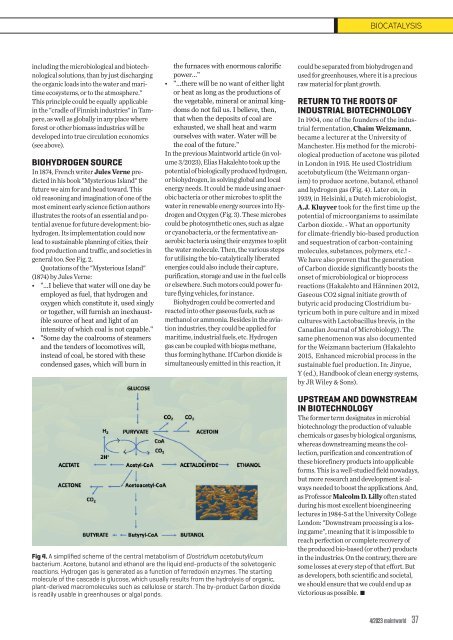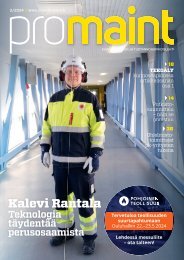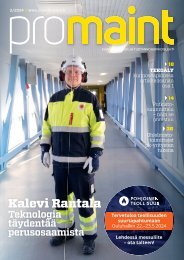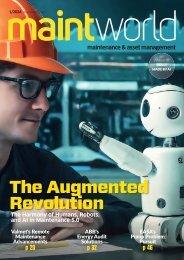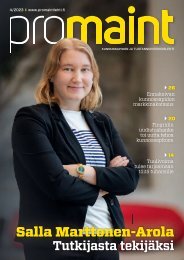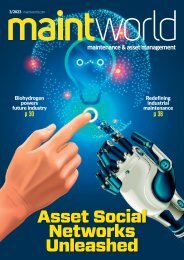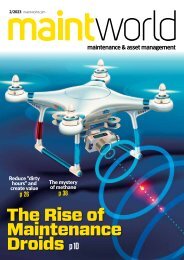Maintworld Magazine 4/2023
- maintenance & asset management
- maintenance & asset management
You also want an ePaper? Increase the reach of your titles
YUMPU automatically turns print PDFs into web optimized ePapers that Google loves.
BIOCATALYSIS<br />
including the microbiological and biotechnological<br />
solutions, than by just discharging<br />
the organic loads into the water and maritime<br />
ecosystems, or to the atmosphere."<br />
This principle could be equally applicable<br />
in the "cradle of Finnish industries" in Tampere,<br />
as well as globally in any place where<br />
forest or other biomass industries will be<br />
developed into true circulation economics<br />
(see above).<br />
BIOHYDROGEN SOURCE<br />
In 1874, French writer Jules Verne predicted<br />
in his book "Mysterious Island" the<br />
future we aim for and head toward. This<br />
old reasoning and imagination of one of the<br />
most eminent early science fiction authors<br />
illustrates the roots of an essential and potential<br />
avenue for future development: biohydrogen.<br />
Its implementation could now<br />
lead to sustainable planning of cities, their<br />
food production and traffic, and societies in<br />
general too. See Fig. 2.<br />
Quotations of the "Mysterious Island"<br />
(1874) by Jules Verne:<br />
• "...I believe that water will one day be<br />
employed as fuel, that hydrogen and<br />
oxygen which constitute it, used singly<br />
or together, will furnish an inexhaustible<br />
source of heat and light of an<br />
intensity of which coal is not capable."<br />
• "Some day the coalrooms of steamers<br />
and the tenders of locomotives will,<br />
instead of coal, be stored with these<br />
condensed gases, which will burn in<br />
the furnaces with enormous calorific<br />
power..."<br />
• "...there will be no want of either light<br />
or heat as long as the productions of<br />
the vegetable, mineral or animal kingdoms<br />
do not fail us. I believe, then,<br />
that when the deposits of coal are<br />
exhausted, we shall heat and warm<br />
ourselves with water. Water will be<br />
the coal of the future."<br />
In the previous <strong>Maintworld</strong> article (in volume<br />
3/<strong>2023</strong>), Elias Hakalehto took up the<br />
potential of biologically produced hydrogen,<br />
or biohydrogen, in solving global and local<br />
energy needs. It could be made using anaerobic<br />
bacteria or other microbes to split the<br />
water in renewable energy sources into Hydrogen<br />
and Oxygen (Fig. 3). These microbes<br />
could be photosynthetic ones, such as algae<br />
or cyanobacteria, or the fermentative anaerobic<br />
bacteria using their enzymes to split<br />
the water molecule. Then, the various steps<br />
for utilising the bio-catalytically liberated<br />
energies could also include their capture,<br />
purification, storage and use in the fuel cells<br />
or elsewhere. Such motors could power future<br />
flying vehicles, for instance.<br />
Biohydrogen could be converted and<br />
reacted into other gaseous fuels, such as<br />
methanol or ammonia. Besides in the aviation<br />
industries, they could be applied for<br />
maritime, industrial fuels, etc. Hydrogen<br />
gas can be coupled with biogas methane,<br />
thus forming hythane. If Carbon dioxide is<br />
simultaneously emitted in this reaction, it<br />
could be separated from biohydrogen and<br />
used for greenhouses, where it is a precious<br />
raw material for plant growth.<br />
RETURN TO THE ROOTS OF<br />
INDUSTRIAL BIOTECHNOLOGY<br />
In 1904, one of the founders of the industrial<br />
fermentation, Chaim Weizmann,<br />
became a lecturer at the University of<br />
Manchester. His method for the microbiological<br />
production of acetone was piloted<br />
in London in 1915. He used Clostridium<br />
acetobutylicum (the Weizmann organism)<br />
to produce acetone, butanol, ethanol<br />
and hydrogen gas (Fig. 4). Later on, in<br />
1939, in Helsinki, a Dutch microbiologist,<br />
A.J. Kluyver took for the first time up the<br />
potential of microorganisms to assimilate<br />
Carbon dioxide. - What an opportunity<br />
for climate-friendly bio-based production<br />
and sequestration of carbon-containing<br />
molecules, substances, polymers, etc.! -<br />
We have also proven that the generation<br />
of Carbon dioxide significantly boosts the<br />
onset of microbiological or bioprocess<br />
reactions (Hakalehto and Hänninen 2012,<br />
Gaseous CO2 signal initiate growth of<br />
butyric acid producing Clostridium butyricum<br />
both in pure culture and in mixed<br />
cultures with Lactobacillus brevis, in the<br />
Canadian Journal of Microbiology). The<br />
same phenomenon was also documented<br />
for the Weizmann bacterium (Hakalehto<br />
2015, Enhanced microbial process in the<br />
sustainable fuel production. In: Jinyue,<br />
Y (ed.), Handbook of clean energy systems,<br />
by JR Wiley & Sons).<br />
Fig 4. A simplified scheme of the central metabolism of Clostridium acetobutylicum<br />
bacterium. Acetone, butanol and ethanol are the liquid end-products of the solvetogenic<br />
reactions. Hydrogen gas is generated as a function of ferredoxin enzymes. The starting<br />
molecule of the cascade is glucose, which usually results from the hydrolysis of organic,<br />
plant-derived macromolecules such as cellulose or starch. The by-product Carbon dioxide<br />
is readily usable in greenhouses or algal ponds.<br />
UPSTREAM AND DOWNSTREAM<br />
IN BIOTECHNOLOGY<br />
The former term designates in microbial<br />
biotechnology the production of valuable<br />
chemicals or gases by biological organisms,<br />
whereas downstreaming means the collection,<br />
purification and concentration of<br />
these biorefinery products into applicable<br />
forms. This is a well-studied field nowadays,<br />
but more research and development is always<br />
needed to boost the applications. And,<br />
as Professor Malcolm D. Lilly often stated<br />
during his most excellent bioengineering<br />
lectures in 1984-5 at the University College<br />
London: "Downstream processing is a losing<br />
game", meaning that it is impossible to<br />
reach perfection or complete recovery of<br />
the produced bio-based (or other) products<br />
in the industries. On the contrary, there are<br />
some losses at every step of that effort. But<br />
as developers, both scientific and societal,<br />
we should ensure that we could end up as<br />
victorious as possible.<br />
4/<strong>2023</strong> maintworld 37


